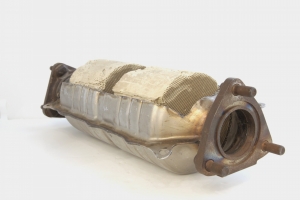
Many of the gases produced by cars as the result of the combustion of petrol are toxic to humans and harmful to the environment, including nitrogen oxides, carbon monoxide and hydrocarbons. These gases are produced because there is enough oxygen available to oxidize the carbon fuel in these engines completely into carbon dioxide and water. We have therefore invented technologies like the catalytic converter to reduce the impact of these harmful gases. Catalytic converters are used in vehicle exhausts systems to provide a site for the oxidation and reduction of about 98% of those toxic by-products into less hazardous substances like carbon dioxide, water vapor, and nitrogen gas.
Catalytic converters were invented by a French engineer in the USA in the 1950s. His invention relied on a metal casing that had a coating of platinum on the inside to speed up (catalyse) the oxidation of the car exhaust fumes. However, the use of leaded petrol initially scuppered his invention, as the lead in the petrol coated the inside of the converter and prevented exhaust fumes from coming into contact with the catalyst. When the Environment Protection Agency in the USA introduced stricter regulations on toxic emissions in the 1970s, this led to the removal of lead from petrol in the States and the compulsory use of catalytic converters on car engines. The UK and EU were slower to make changes: catalytic converters didn’t become a legal requirement in the UK until the 1990s, and leaded petrol was not phased out until 2000.
Modern day catalytic converters are ceramic honeycomb structures that are coated with precious metals such as platinum, palladium and rhodium. Because of the precious metals coating catalytic converters, and a recent skyrocketing of the price of these metals, they have increasingly become the target of theft as they are worth hundreds of pounds and are easy to access.
Although catalytic converters solve one problem, researchers have suggested they are also responsible for higher environmental levels of platinum group metals in the atmosphere, soil, surface water and even Antarctic ice, as a result of nano- and micro-particles of the coatings that are emitted in exhaust fumes.
Sample ID: 848
Particularities
- Selections
- Healthy Materials
- Curiosities
- Transformative
- Relationships
- Automotive | Catalysis | Ceramic | Gases | Greenhouse gases | Harmful | Heavy Metals | Honeycomb | Precious | Precious Metals | Sustainability | Value
Add materials you find interesting to your own selections.
Use the  button to select a material and get started.
button to select a material and get started.




